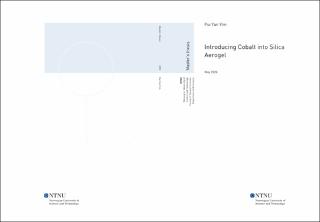| dc.description.abstract | This thesis is the continuation of a master project done by Sondre Håbrekke. Cobalt was tried to introduce into the matrix of silica aerogel in single site via sol-gel method. Cobalt silica aerogel was prepared by using sodium silicate, following by ambient pressure drying (ADP). Introduction of cobalt was done by adding the cobalt cation into the sol prior to gelation. Surface hydrophobization and solvent exchange were performed simultaneously using the instantaneous solvent exchange/surface modification (ISE/SM) process. Silica aerogel was prepared under different conditions (ie gelation pH and surface modification temperature) and using different parameters (ie. types of precursors, silylation agents and exchange solvents) to investigate the possibility to incorporated cobalt in single site.
Different characterization techniques were performed to study how the introduction of cobalt affects the structure of silica aerogel. X-ray diffraction (XRD) was used to identify unwanted crystalline phases in the gel. Nitrogen adsorption/desorption isotherm was used to estimate the total surface area and pore size, where inductively coupled plasma mass spectrometry (ICP-MS) was used to measure the uptake of cobalt into the gel. X-ray absorption spectroscopy (XAS) analysis was performed to obtain information about the oxidation state and the local environment of the cobalt cation. Extended X-ray absorption fine structure (EXAFS) spectra showed only the first shell that attributed to Co-O scattering pairs at ~2 Å. The absence of the second shell contribution attributed to Co---Co confirmed that the cobalt was successfully introduced into silica aerogel in single site. Amorphous structure, the surface area of the gel and local environment of cobalt species in the gel remain almost the same after annealing, indicating the material is thermally stable up to 450°C. | |
